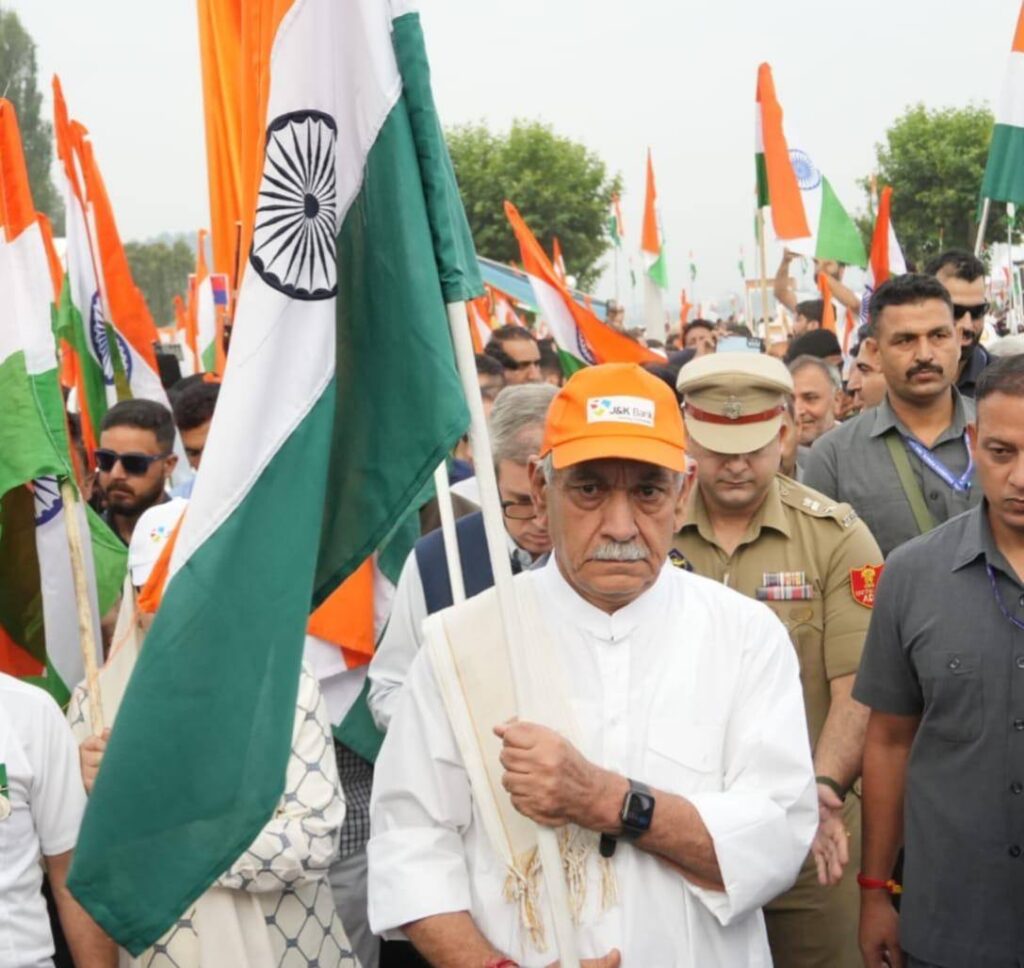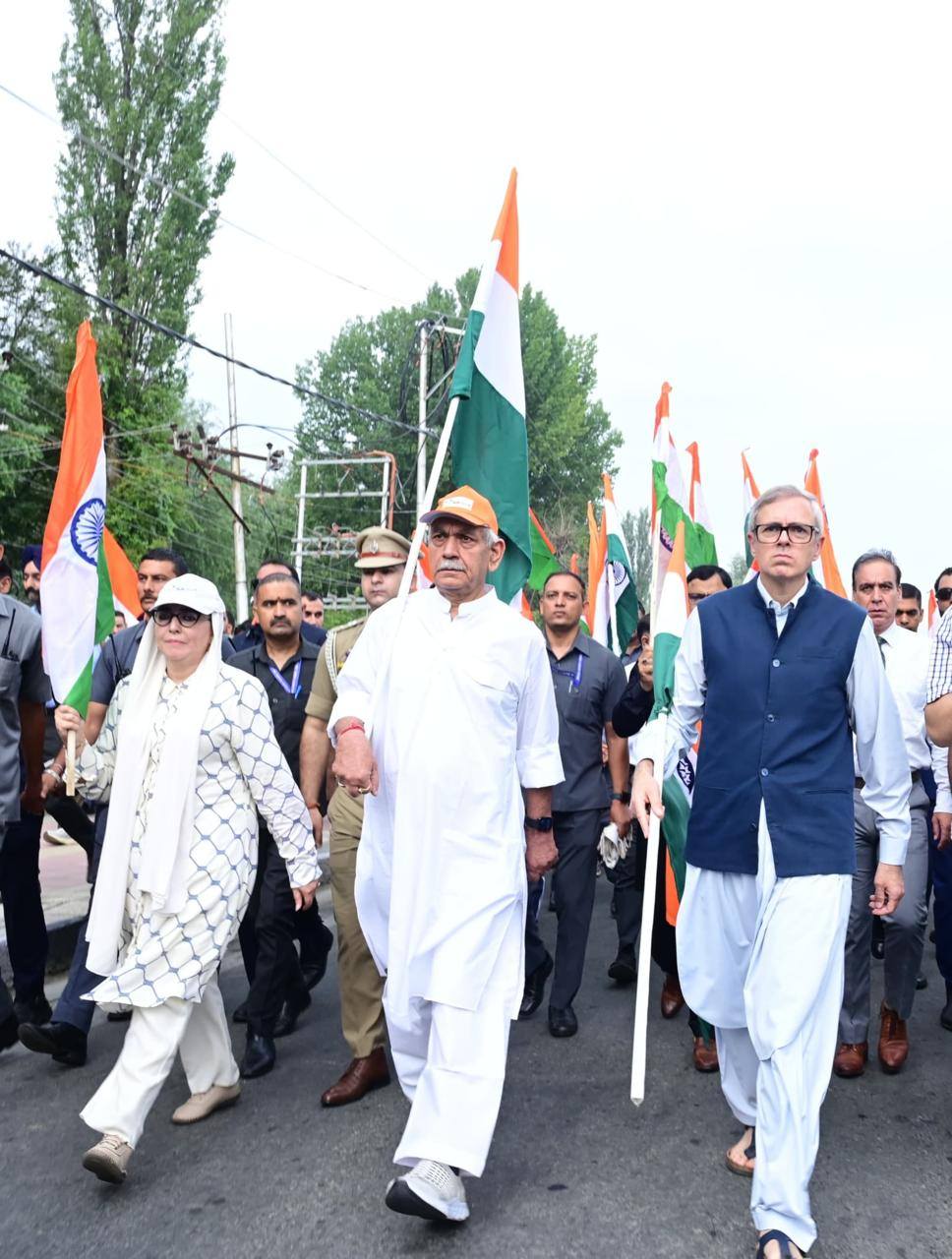By Ajaz Rashid
The first light of morning touched the rippling surface of Dal Lake like a painter’s brush, turning its calm waters into molten gold. Houseboats bobbed gently in place, their wooden hulls whispering against the moorings as the breeze carried faint notes of drums, bugles, and patriotic songs from the boulevard. In the far distance, the outline of the Zabarwan Range stood watch — its peaks softened by a curtain of early mist.
By the time the first saffron banners appeared along the lakefront, the crowd had already swelled to thousands. Students in neatly pressed uniforms clutched miniature flags; elderly men in woollen pherans leaned on walking sticks, their eyes scanning the horizon; women draped in saris and shawls that echoed the tricolour’s palette stood in small, smiling groups. Security personnel in crisp uniforms lined the route, their stance both watchful and welcoming.
It was here, against this tableau of colour and anticipation, that Lieutenant Governor Manoj Sinha emerged from the assembly, walking towards a small ceremonial stage adorned with marigolds and a giant tricolour. At precisely 8:30 a.m., with television cameras trained on him and the crowd chanting “Bharat Mata Ki Jai,” he stepped forward to flag off the Tiranga Yatra.
The rally — or more precisely, the walkathon — would trace a route from Dal Lake to the Botanical Garden. But the journey was more than geographical. It was emotional, symbolic, and in its own way, political. It was a declaration that, at least for this morning, the lines that had once divided people here were replaced by a shared affirmation of identity.

Sinha held the flag close to his chest and addressed the gathering. His voice was steady but tinged with feeling.
“Tiranga is my Dharma. Tiranga is my strength. Tiranga is my heartbeat,”
he said, pausing for a moment as the crowd’s cheers swelled. Then, in Hindi, he recited a line that hung in the air like a benediction:
“कर्म हेतु इस धर्म भूमि पर लें फिर फिर हम जन्म सहर्ष — For the sake of duty, may we again and again take birth on this holy land. भारत माता की जय!”
The procession began to move, a river of saffron, white, and green winding its way along the lake’s edge. Tricolour scarves fluttered in the breeze. Schoolchildren sang in unison; shopkeepers stepped out to wave; petals rained down from balconies. In the rhythm of marching feet and in the quiet smiles exchanged between strangers, one could sense an intangible shift — a moment of unity.
In his main address, Sinha paid homage to “forefathers and brave hearts” who had given their lives for the flag’s glory.
“Today is the day to celebrate the success of our great nation, however, we should also introspect about our duties and build on our successes,”
he said, urging collective resolve
“to build the edifice of modern and prosperous J&K on the foundation of sacrifices of our soldiers of Army, CAPFs and Police.”
Sinha described a new chapter unfolding in the Union Territory’s history.
“With renewed self-confidence and faith, the people of J&K are writing their own destiny. The unfulfilled dreams of generations are finally being realized.”
He credited recent cultural and public events — from the “Weaves & Threads” initiative in schools to Tiranga Bike Rallies — with reviving the spirit of the freedom movement.
“The skies of Jammu and Kashmir are shining with the tricolor… a new generation is rising, dedicated to the honour and glory of the tricolor. They have one resolve — to live and die for Maa Bharti.”
A Rally Born from Resilience
Just behind the front line of marchers, another striking image emerged: Lieutenant Governor Manoj Sinha and Chief Minister Omar Abdullah walking side by side as they led the procession. The symbolism was unmistakable. For decades, political rivalry, ideological differences, and the unique constitutional status of Jammu and Kashmir had kept elected leaders and the Centre’s representatives at arm’s length in public demonstrations of nationalism. Today, that distance seemed to close — if only for the length of the march.

Sinha summed up the moment succinctly:
“Flagged off Tiranga Yatra from Dal Lake. Thousands of people proudly joined to honour national flag, which symbolizes our unity, pride & shared identity.”
For Omar Abdullah, the rally was also an opportunity to share a personal reflection on the power of individual action. Standing before the crowd, his voice rose with a mix of nostalgia and conviction.
“Usually we say, or hear from others, that what one can change being alone, but remember the days when we were not allowed to hoist our flags at homes,” he began.
He recounted the story of one determined Indian who, after studying in the United States, was struck by the sight of his peers proudly displaying their national flags in their rooms. Returning home, he found himself barred by law from doing the same.
The message was clear: change, even at the national level, can begin with one person’s determination.
“The gist is one can bring change by their own. We should uphold the prestige of the national flag, it is our identity, we should respect it,”
he concluded, earning applause from the crowd.
Boats, Balloons, and a Cultural Renaissance
The day’s visual spectacle was nothing short of cinematic. Dal Lake — often described as the “Jewel of Kashmir” — was transformed into a floating tribute to the tricolour. Shikaras, the region’s iconic wooden boats, were decked in fabric panels of saffron, white, and green. From the shore, hundreds of balloons, each carrying a miniature flag, drifted into the sky, their reflections shimmering on the water’s surface.
The rally concluded with a sequence of cultural performances. Folk singers belted out songs of sacrifice and freedom. Kargil War heroes were felicitated in a poignant ceremony that left more than a few eyes moist. As the LG and CM mingled with participants, a common refrain emerged — a shared pride, a renewed resolve, and the recognition that patriotism could be celebrated in Kashmir without fear.
Security and Symbolism in a Sensitive Time
The rally took place under tight but unobtrusive security. The shadow of the April 2025 Pahalgam terrorist attack — which claimed 26 lives, most of them Hindu tourists — still loomed large. That attack, the deadliest civilian tragedy in Kashmir since the 2008 Mumbai carnage, had tested the region’s resilience.
Sinha referenced recent security operations in his remarks, praising the forces for
“Avenging the Pahalgam attack”
through the elimination of its perpetrators in July. The symbolism was impossible to ignore: this was not merely a rally of celebration but a defiant stand against those who sought to disrupt peace.
Historical Resonance and Future Aspirations
In the wider arc of Kashmir’s history, the Tiranga Yatra was more than ceremonial. It was a marker of change since the 2019 abrogation of Article 370. In earlier decades, such large-scale voluntary participation in a patriotic event might have been unthinkable.

The “Har Ghar Tiranga” campaign, of which this rally formed a part, has gained unusual traction in the Valley. Hoisting the national flag at private homes — once a politically fraught act — is becoming increasingly common.
A Valley in Transition
By midday, as the march reached the Botanical Garden, the streets behind were strewn not with debris but with petals. Children clutched their miniature flags like keepsakes. Elderly men sat along the roadside, talking quietly about the day’s events.
In a region where the tricolour has often been a contested symbol, the rally suggested a subtle but real shift. Whether it signalled reconciliation, pragmatism, or simply a new chapter in the Valley’s complex story remains to be seen. But for a few hours, along the shimmering expanse of Dal Lake, “Tiranga is my strength, Tiranga is my heartbeat” was not just a leader’s slogan — it was the shared rhythm of the crowd.
